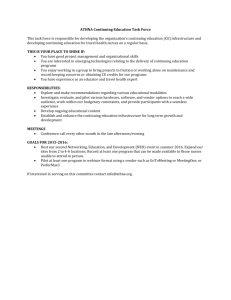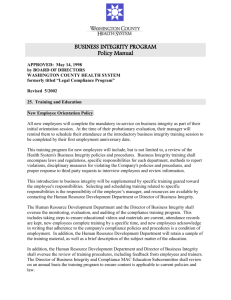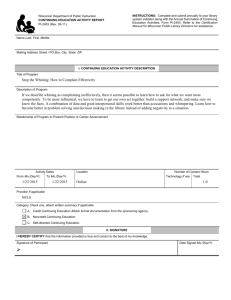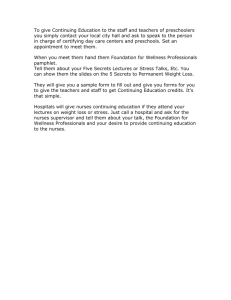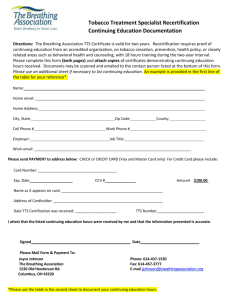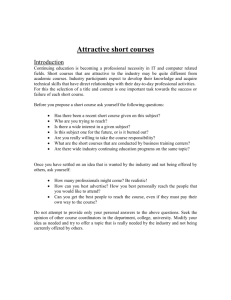Abstract - Ahima - American Health Information Management
advertisement
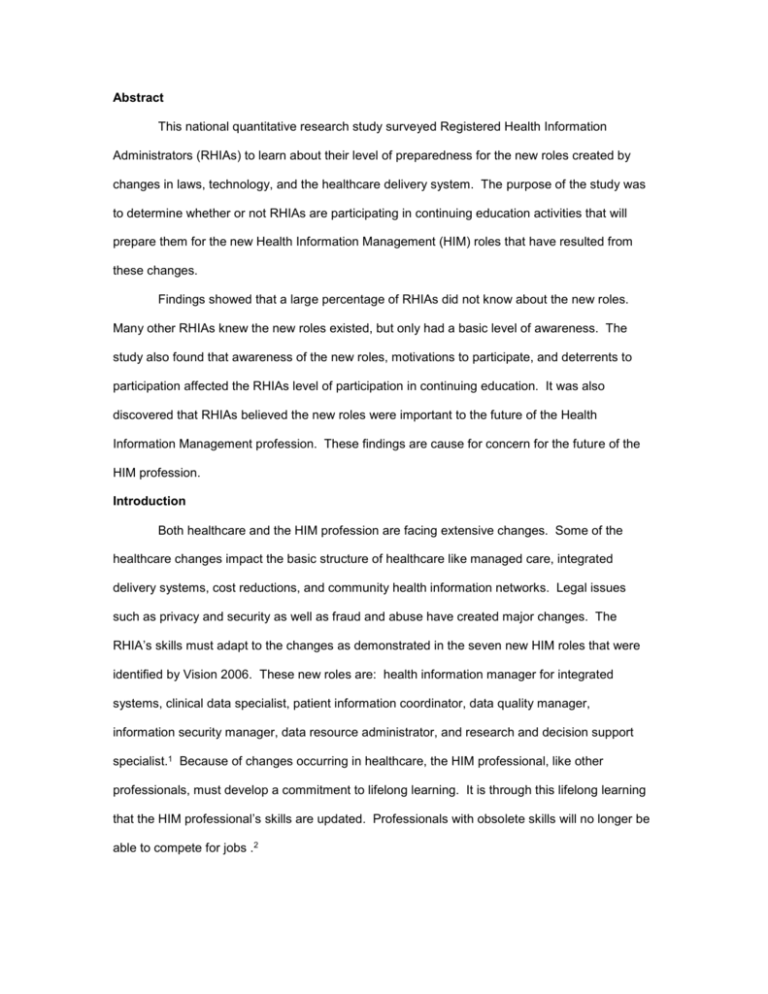
Abstract This national quantitative research study surveyed Registered Health Information Administrators (RHIAs) to learn about their level of preparedness for the new roles created by changes in laws, technology, and the healthcare delivery system. The purpose of the study was to determine whether or not RHIAs are participating in continuing education activities that will prepare them for the new Health Information Management (HIM) roles that have resulted from these changes. Findings showed that a large percentage of RHIAs did not know about the new roles. Many other RHIAs knew the new roles existed, but only had a basic level of awareness. The study also found that awareness of the new roles, motivations to participate, and deterrents to participation affected the RHIAs level of participation in continuing education. It was also discovered that RHIAs believed the new roles were important to the future of the Health Information Management profession. These findings are cause for concern for the future of the HIM profession. Introduction Both healthcare and the HIM profession are facing extensive changes. Some of the healthcare changes impact the basic structure of healthcare like managed care, integrated delivery systems, cost reductions, and community health information networks. Legal issues such as privacy and security as well as fraud and abuse have created major changes. The RHIA’s skills must adapt to the changes as demonstrated in the seven new HIM roles that were identified by Vision 2006. These new roles are: health information manager for integrated systems, clinical data specialist, patient information coordinator, data quality manager, information security manager, data resource administrator, and research and decision support specialist.1 Because of changes occurring in healthcare, the HIM professional, like other professionals, must develop a commitment to lifelong learning. It is through this lifelong learning that the HIM professional’s skills are updated. Professionals with obsolete skills will no longer be able to compete for jobs .2 Part of this study was to develop a model to predict if awareness of the new role, motivation to participate, deterrents to participation, and perceived importance of the new role impacted the amount of participation in continuing education. Independent Variables Awareness of new roles Deterrents to participation Dependent Variable Amount of Participation (in hours) Motivation to participate Perceived importance of new roles Figure 1. Drawing representing conceptual framework: This shows the connection of awareness, deterrents, motivation, and perceived importance of the new roles to the amount of participation in continuing education on the new roles. Research Questions The following research questions were used for the proposed study: 1. Are Registered Health Information Administrators aware of the new Health Information Management roles and to what extent do they think each role is important to the future of the profession? 2. What deters and what motivates Registered Health Information Administrators to participate in continuing education on the new roles? 3. How are Registered Health Information Administrators participating in continuing education on the new roles? Literature Review The literature clearly documents the many changes facing healthcare and the HIM profession. These changes include a wide range of areas including the basic structure of the healthcare system itself, technology, changes in legislation, changes in the way that healthcare providers are reimbursed, e-health, and the computerized patient record. These changes will require the HIM professional to update his or her skills in order to function in the new environment. The future HIM professional will assume new roles which have been created in response to the changes.1 There is a wide range of motivations for participation. Participants in adult education frequently do so for career reasons, personal enrichment, a college degree, or to prepare for a job.3 The most common reason for participation is career related.4 Scanlan and Darkenwald identified six deterrents to participation factors: disengagement, cost, family constraints, benefit, lack of quality, and work constraints.5 Nowlen believes that continuing education is a lifetime commitment. 1 He wrote that the education should be both formal and informal. Continuing education methods can include professional meetings, vendor meetings, teleseminars, formal college credit, approved independent study programs, publications, and speaking at an educational program. 6 Methodology Self-administered questionnaires were mailed to 800 randomly selected RHIAs across the nation. The questionnaire development process included: review of prototype instrument by research experts, prepilot review of prototype instrument by content experts, review by the dissertation committee, and a pilot study using the pilot instrument. Reliability and validity were built into the research through the questionnaire development process, the use of additive scales, the adaptation of Hall and Hord’s Stages of Concern theory, and the review of the literature. The sample was made up of RHIAs who were active members of the American Health Information Management Association who were currently working in a HIM related field. The questionnaire used Likert type scales for importance of new roles and motivations/deterrents to participation, Open ended and forced choice questions were used to collect data was on continuing education experiences, awareness of the new roles, and background information. The usable return rate was 36.0%. The following table describes the respondents. Table 1 Description of Respondents Variable Value Gender Male Female 26 (9.0%) 256 (89.7%) Age n 286 Mean = 44.41; sd = 9.25; minimum = 23; maximum = 65 Race/Ethnicity White: African American Hispanic Asian 228 (82.3%) 25 (9.0%) 11 (4.0%) 10 (3.6%) Number of years until retirement mean = 17.68; sd = 9.23 277 277 206 Findings The study found that there were a large numbers of RHIAs who do not know about the new roles outlined in Vision 2006. Many of the RHIAs surveyed (28.1%) did not know about the new roles and many others knew little more about them than their existence (33.8%). The study found that RHIAs are primarily motivated to participate in continuing education to maintain their skills. The strongest deterrent, based on the mean, was the quality of the continuing education programs available, with time ranked closely behind. The RHIAs felt that all of the seven new roles were important to the future of the profession. The highest level of agreement, based on the mean, was Health Information Manager for Integrated Systems role. The most widely used methods of continuing education were the traditional methods of continuing education. Reading journals and attending seminars were the top two methods of continuing education used to learn about the new roles. According to the conceptual framework, perceived importance of the new role had no impact on the number of hours of continuing education on the new roles, so it was removed from the framework. Awareness of the new roles and motivation to participate had a positive impact on the number of hours of continuing education on the new roles. Deterrents to participation had a negative impact on the amount of participation in continuing education. Table 2 Awareness of New Roles (n=281) Level of Awareness Frequency (Percentage) I have never heard of Vision 2006. 79 (28.1%) I know that the new roles exist, but not much else. 95 (33.8%) I have a basic understanding of the new roles, but do not think they impact me. 20 (7.1%) I have a basic understanding of the new roles, but I do not know how they will impact me. 33 (11.7%) I am trying to decide how to implement the new roles in my job. 18 (6.4%) I am implementing the new roles in my job. 22 (7.8%) I am working with others to implement the new roles. 14 (5.0%) Table 3 Perceived Importance of Role (n=289) Role Mean SD Role #1: Health Information Manager for Integrated Systems 5.45 0.89 Role #2 Clinical Data Specialist 5.21 0.93 Role #3: Patient Information Coordinator 4.61 1.22 Role #4: Data Quality Manager 5.30 0.93 Role #5: Information Security Manager 5.29 1.08 Role #6: Data Resource Administrator 4.87 1.15 Role #7: Research Specialist 4.58 1.17 Table 4 Individual Motivators (n=288) Motivation item Mean SD Learning about the new roles is enjoyable. (n=288) 4.56 1.15 Learning about the new roles is expected of me by others. (n=288) 4.11 1.41 Learning about the new roles will allow me to help others. (n=285) 4.76 1.15 Learning about the new roles will allow me to meet new people. (n=285) 4.5 1.22 Learning about the new roles will enable me to update my skills. (n=287) 5.16 1.02 Learning about the new roles will enable me to make a change in my job. (n=285) 4.61 1.30 Deterrent items Mean SD I do not have enough time to learn about the new roles. 3.49 1.55 It costs too much to learn about the new roles. 3.15 1.43 I cannot find any quality programs on the new roles. 3.53 1.35 I have too many family responsibilities to learn about the new roles. 1.28 1.58 I am not interested in the new roles. 2.45 1.48 I have too many job commitments to learn about the new roles. 3.34 1.49 Table 5 Individual Deterrents Results (n= 286) Table 6 Continuing Education Methods Used (in hours) Activity Mean hours SD n I taught myself about the new roles by watching others. 9.30 31.31 271 I learned about the new roles by talking to others. 9.11 26.08 270 I learned about the new roles by reading about the new roles in professional journals. 11.46 28.58 273 I read about the new roles in books. 4.83 21.94 272 I read about the new roles on the Internet. 5.22 16.06 274 I attended college courses related to the new roles. 3.87 23.22 275 I attended seminars or other professional meetings to learn about the new roles. 11.29 20.96 273 Table 7 Conceptual Framework Analysis Independent variable b Beta Statistical Significance Motivations to participate 21.5 .15 .02 Deterrents to participation -24.4 -.20 .002 Awareness of the new roles 9.5 .14 .04 *R2 = .13; F – 12.0; p = .001 Discussion The findings show that overall RHIAs are not spending a lot of time learning about the new roles in spite of the fact that the RHIAs agree with the roles. This lack of participation in continuing education on the new roles is not surprising since many RHIAs did not even know that Vision 2006, or the encompassing new roles existed. This is in spite of the fact that an extensive media campaign was waged to educate RHIAs on Vision 2006. RHIAs need to be educated on the new roles and how important these new roles are to the future of the profession, and then to implement them into their job. Adopting the new roles will become more and more important as more healthcare organizations increase the amount of technology used. Once presented with the new roles, the RHIAs agreed that the new roles identified in Vision 2006 were important to the future of the profession. Understanding the motivation and deterrents to participation will allow providers of continuing education to better meet the needs of the RHIA (Merriam & Brockett). Because of the continuing education requirements mandated for retention of the RHIA credential, it was no surprise that updating skills was the primary motivator. It was surprising that poor quality continuing education programs was the primary deterrent to participation. HIM continuing education providers need to learn what the RHIA expects out of the continuing education experience and what make them see the sessions as poor quality. This study does not ask who conducted the poor quality programs, how poor quality is defined, or what should be done to improve them. RHIAs are relying on journals and seminars to prepare them for the new roles. Because of the complexity of the skills required by the new roles, journals and seminars may not be enough. RHIAs may need to attend college courses whether they go back for a degree or just take a few courses. These college courses will be more detailed and thorough than any seminar or journal article can be. The advent of online college courses may eventually remove some of the barriers and thus encourage RHIAs to enroll. Other barriers to participating in continuing education such as time may need to be addressed. The RHIAs may need to change their continuing education practices since continuing education is more than the formal methods that are approved for continuing education hours required to maintain credentials. Continuing education also includes reading professional journals, speaking with others, and surfing the Internet. Once the RHIA realizes all of the continuing education opportunities that are available, then he or she will have more options to prepare him or her for the future. Implications, Limitations, Conclusions Based on the findings of the study, the future of the HIM profession in a technological world is not assured. The findings clearly show that most RHIAs (61.9%) do not know about the future direction of their chosen profession as described in Vision 2006. Learning about the new roles is difficult when the RHIA does not even know the new roles exist, or if his or her knowledge is very limited. The future is up to the RHIA. He or she can make the HIM profession and the RHIA key leaders in healthcare or can sit back and watch others take the lead. If the RHIA decides to take the lead, then updating skills through continuing education is critical. The RHIA should conduct a self-assessment of his or her skills to learn to determine strengths and weaknesses. An individualized career development plan can then be developed based on the findings. Bowman (1997) wrote that professional development is the process of developing and carrying out a plan for acquiring the new knowledge and skills necessary to effectively perform in a professional role. It has paramount importance in the health information management profession at this time because of the rapid changes in health care in general and in health information management in profession (p. 22). Career development is not the same for everyone. The stage in life that a person is in controls his or her choice of educational methods and controls the amount of education that he or she undertakes. In order to participate, the individual must find career development interesting. The professional must see how career development can be merged with his or her personal life. A career development plan should contain objectives for learning and provide a guide for implementing the plan.7 Rudman and Kerns believe that if HIM professionals are to succeed in the future, they must take advantage of available educational opportunities.8 There are a number of career opportunities available to the HIM professional, if he or she has the necessary education to provide them with the skills needed. In fact Rudman & Kerns wrote, “planning, collecting, analyzing, and documenting information are core elements of a market-driven and informationdependent health care organization. For health information professionals who are prepared for these new challenges, leadership opportunities seem limitless” (p. 9). 8 The future of the RHIA is up to the individual and how he or she handles and addresses the changes affecting the HIM profession. As identified in the study, many RHIAs were unaware of or only had a basic understanding of Vision 2006. The methods of communications with RHIAs should be evaluated to determine if there is a better way to communicate with the RHIAs. The lack of knowledge on Vision 2006 is disturbing since the primary method of continuing education reported by the RHIA was reading journals and there was extensive information on Vision 2006 published in the Journal of AHIMA. The effectiveness of communication with the RHIA is important since e-HIM was recently announced. The question then becomes how the RHIA can be motivated to learn about the new roles. One way is to remove the deterrents to participation in continuing education such as making access to continuing education convenient. Another way to motivate RHIAs to learn about the new roles is for AHIMA, state associations, local associations, and the individual RHIA to continue encouraging the need to learn about the new roles. A third possible motivator is changes in the continuing education requirements. One limitation of the study is that the sample includes only members of AHIMA. This excludes RHIAs who maintain their credentials, but choose not to join AHIMA. Another limitation is that study does not include Registered Health Information Technicians so the findings are limited to only RHIAs instead of addressing all HIM professionals. Another limitation is that the number of hours of continuing education on the new roles reported on the questionnaire is not maintained by the participants and therefore could only be an estimate. The RHIA does not track the number of hours spent on informal continuing education either. RHIAs who are not interested in the new roles, who are not aware of the new roles, or not interested in the new roles, may not have completed the questionnaire, thus resulting in a systemic response bias. This could mean that even a lower level of awareness exists than is reported in the findings. The final limitation is the high number of RHIAs who have no or limited knowledge of Vision 2006. This may have made it difficult for them to respond to some of the questions even though a brief description of the new roles was provided on the questionnaire. References 1. American Health Information Management Association. Evolving HIM Careers: Seven roles for the future. Chicago: Author, 1999. 2. Nowlen, P. M. New expectations, new roles: A holistic approach to continuing education for the professions. In R.M. Cervero & J. F. Azzaretto (Eds.), Visions for the future of continuing professional education (pp. 15-78). Athens, GA: The University of Georgia Department of Adult Education, College of Education, Georgia Center for Education, 1990. 3. National Center for Education Statistics. Adult education: Main reasons for participating. (NCES Publication No. 93-451). Washington, D.C.: Author, 1993. 4. Merriam, Sharan B. and Ralph G. Brockett. The Profession and Practice of Adult Education: An Introduction. San Francisco: Josey-Bass, 1997. 5. Scanlan, C.S. and G. G. Darkenwald. Identifying deterrents to participation in continuing education. Adult Education Quarterly, 34, 155-166, 1984 6. American Health Information Management Association. RHIAQ/RHIT Activities that Qualify for CE Credit. http://www.ahima.org/certification/maintenance.rh.ce.cfm 7. Bowman, Elizabeth D. Professional development: Designing a road map to 2006. Journal of AHIMA 68, no. 10, 22, 24, 26, 28-29, 1997 8. Rudman, William J. and L. Kearns. Hospital administrator perceptions of health information managers as future leaders in health care reform. Topics in Health Information Management 15, no. 3, 9-16, 1995

